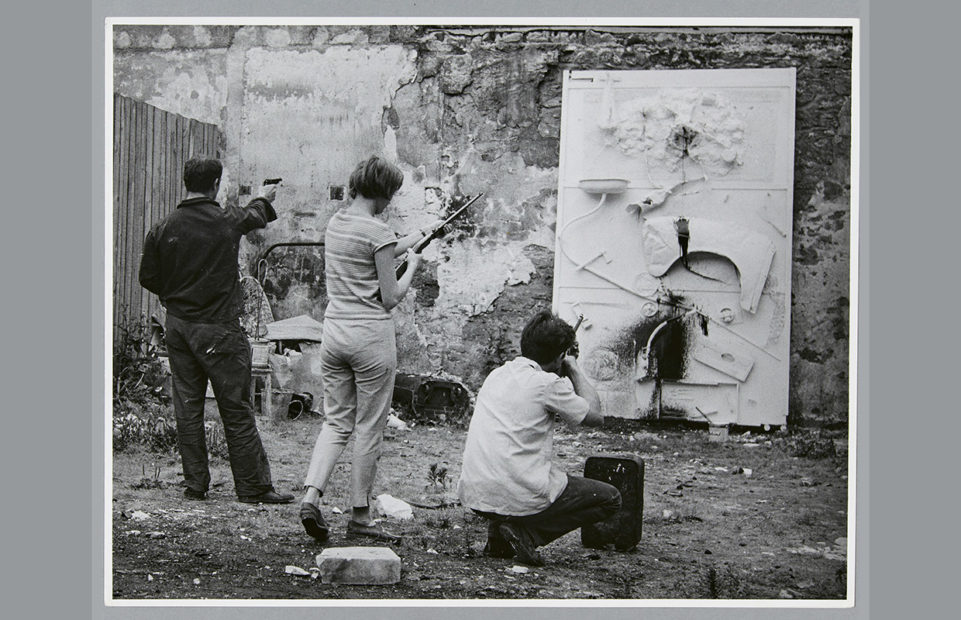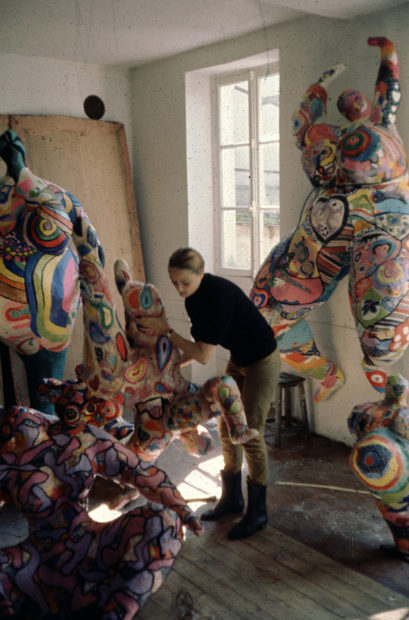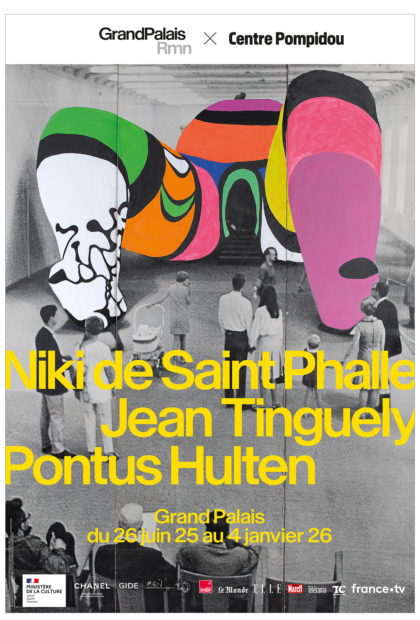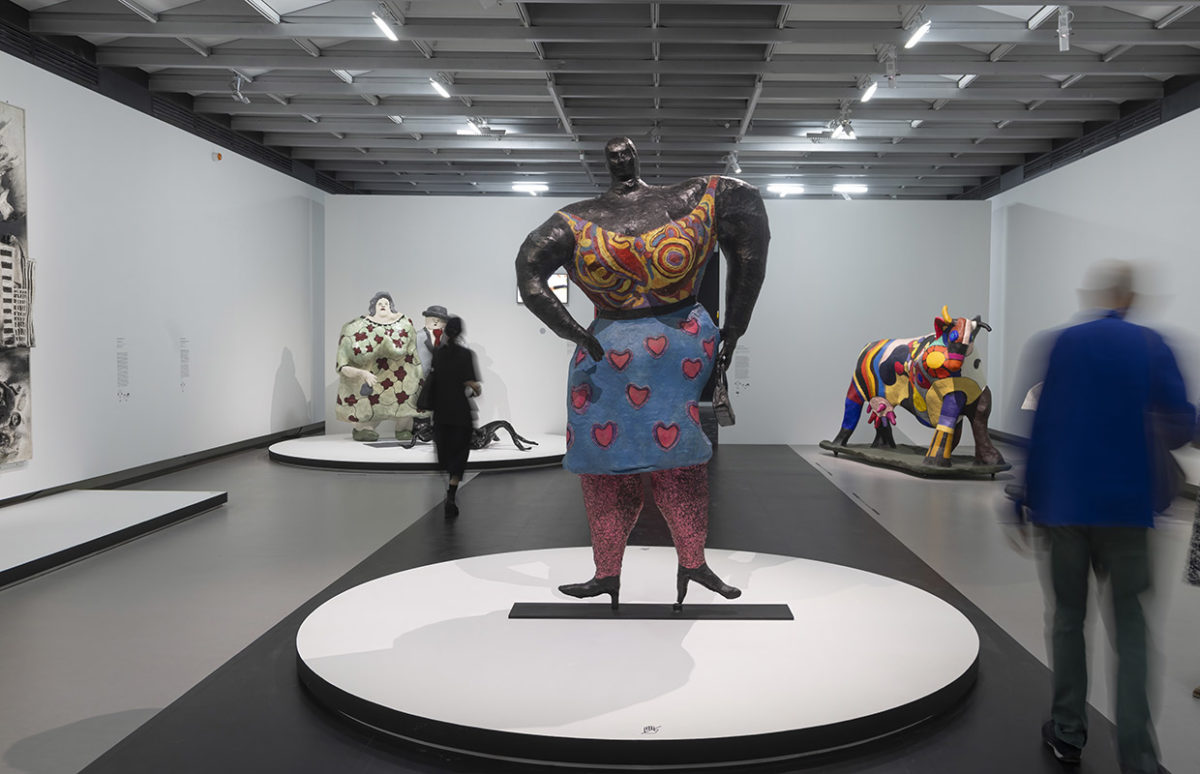The late Franco-American artist Niki de Saint Phalle is everywhere this year, with an exhibition in Aix-en-Provence and the second of the year in Paris. She was one of the first women artists to be recognised in her own lifetime, for works that denounce violence but also ones that celebrate joy and being a woman.
De Saint Phalle was born in Neuilly-sur-Seine in 1930 to an American mother and French father. The family moved to the U.S. when she was three and she spent her formative years in New York state. She suffered abuse at home and was expelled from several schools for rebellious behaviour. She moved back to Europe in her early twenties with her first husband and two children. During a stay in a psychiatric hospital in 1953, she found her way back to health through making art.
Swiss artist Jean Tinguely, who she later married, encouraged her art and helped get her first exhibitions in 1961. These included performance art. Entitled “Tirs”, the canvases were covered with found objects painted and bags of paint. Saint Phalle then shot at the paintings with a shotgun, to burst the bags of paint, which “bled” colour onto the canvas, giving a chance element to the final work. She was invited to join the New Realist movement, which Tinguely was part of.

In 1964, she started her “Nanas” series of brightly coloured sculptures of voluptuous women. The often seemed to be in movement, dancing or jumping, and in fact Tinguely transformed some of them into moving sculptures, his own speciality.

In this short video, Saint Phalle discusses the influence she thinks her “Nanas” and later “Black Heroes” monumental sculptures could have on public perception of women and minorities.
Saint Phalle can be truly said to have lived her art. Her monumental project the Tarot Garden, in Tuscany, took twenty years to complete. It consists of 22 monumental sculptures representing the images in a tarot deck. For several years, Saint Phalle lived inside one of the sculptures as she continued to create the garden.
She spent her final years in California, where she died in 2002.
This video gives a series of views of the Tarot Garden with no voiceover.
Niki de Saint Phalle. Le bestiaire magique
Caumont Centre Art, Aix-en-Provence
30 April-5 October 2025

The exhibition in Aix focuses on Saint Phalle's lifelong fascination with imaginary and mythical creatures and monsters.
Niki de Saint Phalle, Jean Tinguely, Pontus Hultén
Grand Palais, Paris
6 June 2025 to 4 Jan 2026
The exhibition in Paris shows Saint Phalle’s work alongside her husband Jean Tinguely, and looks at the influence on their careers of Pontus Hultén, the first director of the Pompidou Centre.
The poster for the Paris exhibition shows Hon (“She” in Swedish), a monumental “Nana” created by Saint Phalle and Tinguely inspired by an idea of Pontus Hultén’s at the Moderna Museet in Stockholm. Visitors could go inside the sculpture and discover a planetarium, a mil

You can view several works and check out other teaching resources on the Pompidou Centre site. There are also teaching ideas on the Saint Phalle foundation site.
Copyright(s) :
Niki de Saint Phalle, Black Rosy ou My Heart Belongs to Rosy, 1965. Tiissu, fils de laine et peinture sur grillage, 225 × 150 × 85 cm, Niki Charitable Art Foundation, Santee, Californie © 2025 Niki Charitable Art Foundation / Adagp, Paris
Séance de tir de Niki de Saint Phalle, impasse Ronsin, Paris, 26 juin 1961
À gauche : Jean Tinguely
© 2025 Niki Charitable Art Foundation / Adagp, Paris. Photo © Centre Pompidou, MNAM-CCI, Bibliothèque Kandinsky/Fonds Shunk et Kender/Dist. GrandPalaisRmn. Photo Shunk-Kender © J. Paul Getty Trust, tous droits réservés. Gift of the Roy Lichtenstein Foundation in memory of Harry Shunk and Janos Kender
Niki de Saint Phalle entourée de Nanas dans la maison-atelier de Soisy-sur-École, Essonne, vers 1965 © 2025 Niki Charitable Art Foundation / Adagp, Paris. Photo © Georges Kelaidites/Fonds J.B. Gillot/adoc-photos
Niki de Saint-Phalle, Le Dragon Rouge, 1964? Assemblage de plâtre, grillage, tissu, peinture aérosol, ficelle, cheveux et figurines en plastique, 131 x 174 x 96 cm Courtesy Galerie Georges-Philippe et Nathalie Vallois, Paris
© 2025 Niki Charitable Art Foundation / Adagp, Paris, Crédit : André Morin photographe
Tag(s) : "activism" "Aix en Provence" "art" "biography" "civil rights" "exhibition" "feminism" "Niki de Saint-Phalle" "painting" "Paris" "sculpture"






